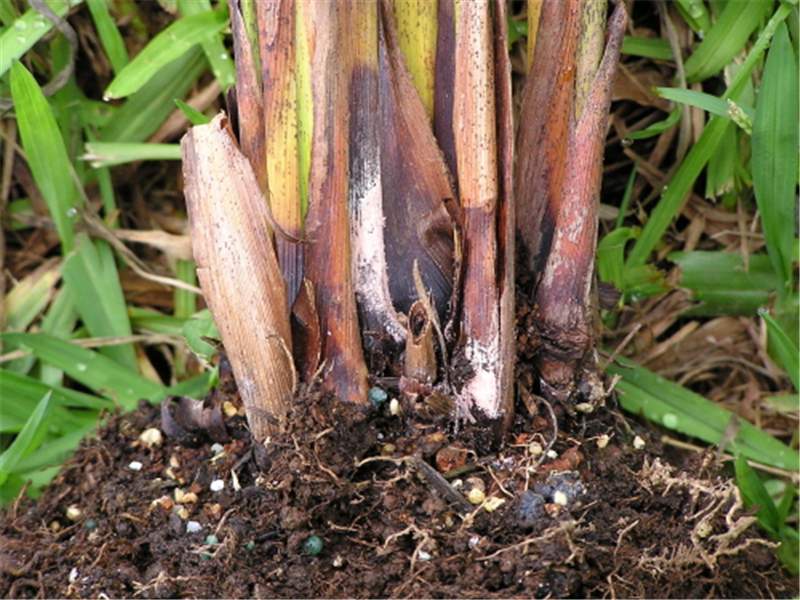Gliocladium Blight and Gliocladium Trunk Rot
|
Figure 1. Pink spore mass of Nalanthamala vermoesenii (=Gliocladium vermoesenii) on palm leaf base. Photo by T. K. Broschat.
|
|
Figure 2. Pink spore mass of Nalanthamala vermoesenii (=Gliocladium vermoesenii) on inflorescence sheath. Photo by A. J. Downer, University of California.
|
|
Figure 3. Pink spore mass of Nalanthamala vermoesenii (=Gliocladium vermoesenii) on spear leaf. Photo by M. L. Elliott.
|
|
Figure 4. Leaf sheath rot of Dypsis lutescens caused by Gliocladium blight. Photo by S. Nelson, University of Hawaii at Manoa.
|
|
Figure 5. Close-up of leaf sheath rot from Fig. 4 illustrating pink spore mass of Nalanthamala vermoesenii (=Gliocladium vermoesenii). Photo by S. Nelson, University of Hawaii at Manoa.
|
Other common names
pink rot
Scientific name of pathogen
Nalanthamala vermoesenii (=Gliocladium vermoesenii): Kingdom Fungi, Imperfect Fungi (no known sexual state)
Hosts
Archontophoenix, Chamaedorea, Chamaerops, Dypsis, Howea, Phoenix, Syagrus, Trachycarpus, and Washingtonia
However, given the wide geographic distribution range of the pathogen, other palms may be undocumented hosts.
Distribution
The pathogen has a worldwide distribution.
Symptoms/signs
The diagnostic sign of this fungus is the large mass of pink, salmon pink or orange pink spores that form on the external surfaces of the affected palm area (Fig. 1-3). The portion of the palm affected by this opportunistic pathogen varies considerably, but is almost always associated with a wound (natural, man-made, insect), weakened host tissue due to unfavorable environmental conditions for the palm (cold, drought), or young budbud:
a common term for meristem; the specialized growing region of a plant containing undifferentiated cells from which new cells and organs are developed
tissue.
The fungus can cause serious problems in small palms, especially in greenhouse situations, where it causes leaf spots, leaf sheath (leaf base) rot (Fig. 4 and 5) and budbud:
a common term for meristem; the specialized growing region of a plant containing undifferentiated cells from which new cells and organs are developed
rot. Symptoms vary based on the disease being caused in each particular situation - e.g., typical leaf spot symptoms are associated with leaf spot disease.
This fungus is also the cause of a trunk rot in Archontophoenix and Chamaedorea. A necroticnecrotic:
see necrosis
lesion (canker) with a water-soaked margin will form on the green trunk tissue, with the typical mass of colored spores forming in this canker. The disease progresses inwards until the stem fails. Although a trunk rot in Syagrus romanzoffiana is often attributed to this fungus, it has not been proven that this fungus is the cause of the symptoms observed, and Gliocladium spore masses are rarely observed on the trunk of this palm species.
May be confused with
If the distinctive pink colored spore mass is not present, the symptoms on seedling and juvenile palms will appear the same as any other leaf spot, leaf sheath blight, or bud rot disease.
Additional comments
The fungus is believed to be more prevalent or causes greater damage in cooler climates or in cooler weather periods. It does not grow above 33 degrees C. It is a ubiquitous fungus that survives equally well as a saprophyte.





